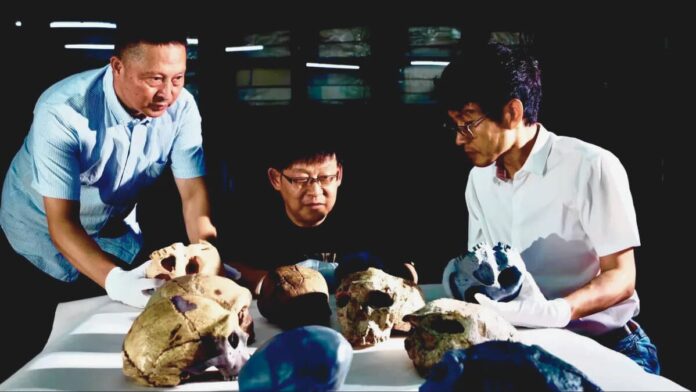A Million-Year-Old Skull Shocks the Scientific Community
A groundbreaking discovery in China may force scientists to rethink the timeline of human evolution. The fossil, known as Yunxian 2, is believed to be over one million years old. According to a joint research team from Fudan University (China) and the Natural History Museum in London, the skull could suggest that Homo sapiens began to emerge at least half a million years earlier than previously thought.
The findings, published in the prestigious journal Science, have already sparked intense debate among anthropologists and evolutionary geneticists.
The Significance of Yunxian 2
When the fossilized skull was first uncovered in Hubei Province, China, it was initially classified as Homo erectus, an early ancestor of modern humans known for walking upright. However, advanced imaging techniques, 3D reconstruction, and comparative genetic analysis suggest otherwise.
Instead, researchers now believe the skull may belong to an early form of Homo longi, sometimes called the “Dragon Man,” a close relative of both Neanderthals and Homo sapiens.
This revelation implies that multiple human species—including Homo longi, Neanderthals, and early Homo sapiens—may have coexisted nearly a million years ago, interacting and even interbreeding.
Voices from the Research Team
Professor Xijun Ni of Fudan University, co-director of the study, described the moment of discovery as “unbelievable”:
“We tested and re-tested with every method available. The results were consistent, and we are confident. It’s incredibly exciting.”
Professor Chris Stringer of London’s Natural History Museum added:
“This analysis pushes back the timeline for the emergence of large-brained humans by at least half a million years. It suggests our evolutionary story is far more complex than we once thought.”
Challenging the Established Timeline
Until now, the earliest confirmed evidence of Homo sapiens came from Africa, dating back around 300,000 years. If Yunxian 2 truly represents a close ancestor of our species, it raises a provocative question: Did modern humans first emerge in Asia, not Africa?
This possibility has divided the scientific community. While some researchers see Yunxian 2 as a revolutionary find, others caution against rushing to conclusions.
Skepticism from the Scientific Community
Dr. Aylwyn Scally, an evolutionary geneticist at Cambridge University, urged caution:
“Dating estimates are extremely challenging. Whether we rely on fossil morphology or genetic evidence, there are always uncertainties. Even with large datasets, it’s very difficult to pinpoint whether different populations overlapped for 100,000 years or more.”
Scally acknowledged that the results could be correct but stressed the need for additional genetic data and independent confirmation.
The Broader Implications
If verified, Yunxian 2 could fundamentally alter our understanding of how human species evolved and interacted. Evidence already shows that different human lineages coexisted for nearly 800,000 years, sharing habitats and occasionally interbreeding.
This new fossil strengthens the argument that human evolution resembled a branching tree rather than a simple linear progression.
Professor Ni summarized it vividly:
“Human evolution is like a tree with three main branches—Homo sapiens, Neanderthals, and Homo longi. These branches lived side by side for almost a million years and may have hybridized. That is an extraordinary conclusion.”
From Broken Bones to Digital Reconstruction
The Yunxian 2 skull was found heavily damaged and compressed, which initially led to its misclassification as Homo erectus. To reassess the fossil, the team used 3D scanning and computer modeling to digitally restore its original shape. Replicas were then produced using 3D printing technology, allowing scientists to examine the skull as it might have appeared in life.
This advanced reconstruction revealed cranial features far more aligned with later human species, prompting its reclassification.
Why It Matters
- Rewriting Human History: If confirmed, the discovery pushes back the origins of Homo sapiens by at least 500,000 years.
- Geographic Shift: It raises the possibility that Asia, not just Africa, played a crucial role in our species’ early development.
- Evolutionary Complexity: Supports the theory of long-term coexistence and interbreeding among different human species.
- New Research Directions: Encourages scientists to re-examine existing fossils worldwide, many of which remain ambiguous in classification.
Final Thoughts
The discovery of Yunxian 2 could become one of the most important archaeological findings of the century. While debates and skepticism continue, one thing is certain: this fossil has reignited the global conversation about where we come from and how many different human lineages shaped our existence.
As Professor Stringer noted, there may still be undiscovered fossils—perhaps millions of years old—that will shed further light on our shared evolutionary past. Until then, Yunxian 2 stands as a reminder that human history is far from fully written.

